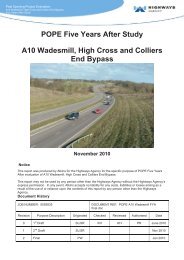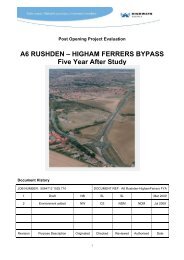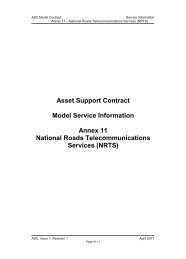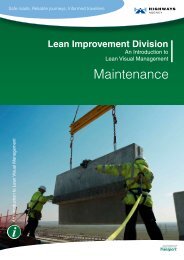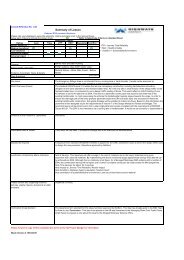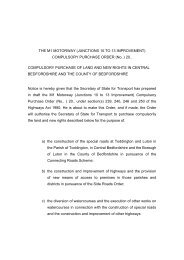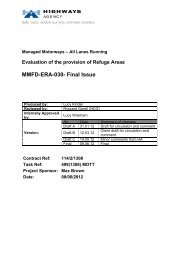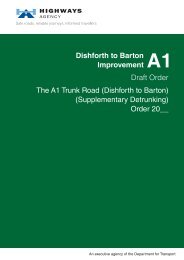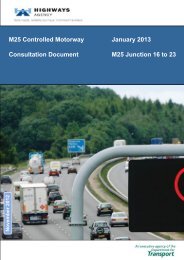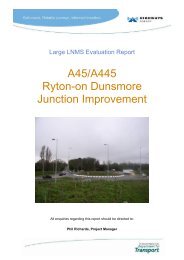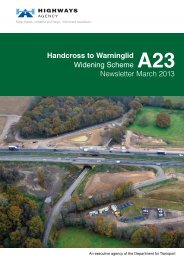Highways Agency Annual Report and Accounts 2011-2012
Highways Agency Annual Report and Accounts 2011-2012
Highways Agency Annual Report and Accounts 2011-2012
You also want an ePaper? Increase the reach of your titles
YUMPU automatically turns print PDFs into web optimized ePapers that Google loves.
SECTION 5: Sustainability <strong>Report</strong><br />
Case Study:<br />
A46 Newark to<br />
Widmerpool<br />
zero waste<br />
to l<strong>and</strong>fill<br />
The upgrade of a 17.5 mile<br />
stretch of the A46 was<br />
designed as a model of<br />
good practice for long term<br />
environmental sustainability.<br />
The project benefited from<br />
an integrated approach to<br />
sustainability, documented<br />
in a sustainability action<br />
plan. This contributed to<br />
a reduced use of finite<br />
materials, lower transport<br />
costs, lower carbon<br />
emissions <strong>and</strong> waste,<br />
specifically:<br />
• Avoidance of 1,143 tCO 2<br />
e<br />
of greenhouse gas<br />
emissions through reuse<br />
of excavated topsoil.<br />
• Use of 115,920 m 3 of site<br />
collected water.<br />
• 100 per cent locally<br />
sourced aggregate, 27 per<br />
cent recycled aggregate.<br />
• Recycling of construction<br />
<strong>and</strong> temporary road<br />
materials.<br />
• Zero construction waste<br />
to l<strong>and</strong>fill.<br />
Hindhead under construction. The<br />
tunnel portals may not have changed<br />
much, but the brightly coloured<br />
s<strong>and</strong>stone gives a clue to how much<br />
material has been excavated. The<br />
excavated material was used as infill<br />
for the old A3 removed from the<br />
Devil’s Punchbowl<br />
gas emissions. In <strong>2011</strong>-12 our<br />
managing agents have exceeded<br />
their target of a three per cent<br />
reduction in greenhouse gas<br />
emissions from their maintenance<br />
vehicles compared to 2010-11.<br />
Switching off road<br />
lighting<br />
To support the Government’s<br />
wider agenda on reducing carbon<br />
emissions we have, since 2009,<br />
been switching lights off or in<br />
some cases removing lighting<br />
on motorways at locations with<br />
good safety records. So far we<br />
have switched off motorway<br />
lighting, between midnight <strong>and</strong><br />
5am, at 14 sites across Engl<strong>and</strong>.<br />
We have also undertaken four<br />
successful full switch-off schemes<br />
- on the M58, M65, M66 <strong>and</strong> the<br />
M1. Evidence suggests that the<br />
<strong>Agency</strong>’s process for selecting<br />
sites for switching off lights is<br />
appropriate as early results<br />
indicate that there has been no<br />
adverse impact on safety at the<br />
sites where lighting has been<br />
switched off.<br />
On 27 March <strong>2012</strong> lighting was<br />
permanently switched off on<br />
the M4 between Junctions 20<br />
<strong>and</strong> 22 as well as on the M48 at<br />
Aust (Junction 1). Almondsbury<br />
Interchange <strong>and</strong> the approaches<br />
will remain lit, as will the Toll Plaza<br />
at M48 Severn Bridge.<br />
Construction waste<br />
We are improving the quality of<br />
data that the <strong>Agency</strong> collects<br />
on waste generated at its<br />
maintenance <strong>and</strong> construction<br />
sites. For the first time we are able<br />
to report the total volume of waste<br />
removed from our major project<br />
sites to l<strong>and</strong>fill which in <strong>2011</strong>-12<br />
was 3,190 tonnes, of a total waste<br />
volume of over 350,000 tonnes.<br />
See the table on page 41 for more<br />
details.<br />
Office waste<br />
In <strong>2011</strong>-12 we have reduced<br />
the volume of waste arising from<br />
our offices by 10 per cent when<br />
compared to 2010-11. 67 per<br />
cent of our office waste was sent<br />
for recycling compared to 63 per<br />
cent in the previous year. We will<br />
seek to improve the management<br />
of office waste by collecting data<br />
about the treatment of our nonrecycled<br />
office waste. We will<br />
use this information to minimise<br />
the volume of office waste sent to<br />
l<strong>and</strong>fill.<br />
Litter removed from the<br />
network<br />
We remove nearly 250,000<br />
sacks of litter from our network<br />
every year, which costs money –<br />
approximately £40 per sack, or<br />
£10 million in total – <strong>and</strong> puts the<br />
safety of our road workers at risk.<br />
Roadside litter is not only<br />
unsightly, but is also a threat to the<br />
environment <strong>and</strong> wildlife, blocking<br />
drains <strong>and</strong> causing flooding.<br />
Clearing litter diverts muchneeded<br />
resources away from road<br />
maintenance <strong>and</strong> repairs, while<br />
items thrown from moving vehicles<br />
can be a hazard to other road<br />
users.<br />
<strong>Highways</strong> <strong>Agency</strong> <strong>Annual</strong> <strong>Report</strong> <strong>and</strong> <strong>Accounts</strong> <strong>2011</strong>-12



